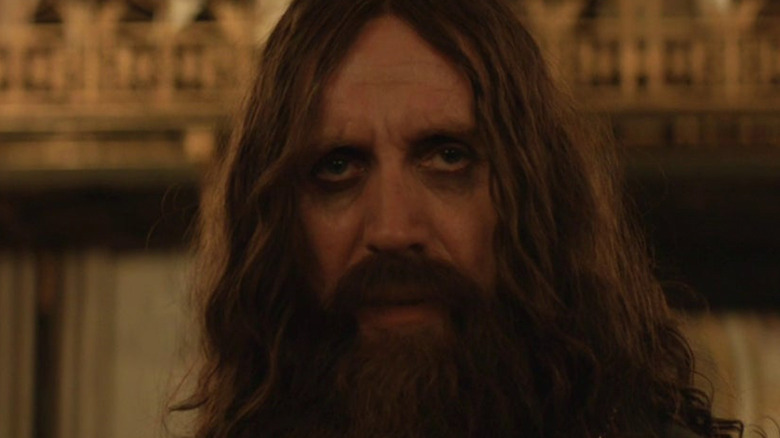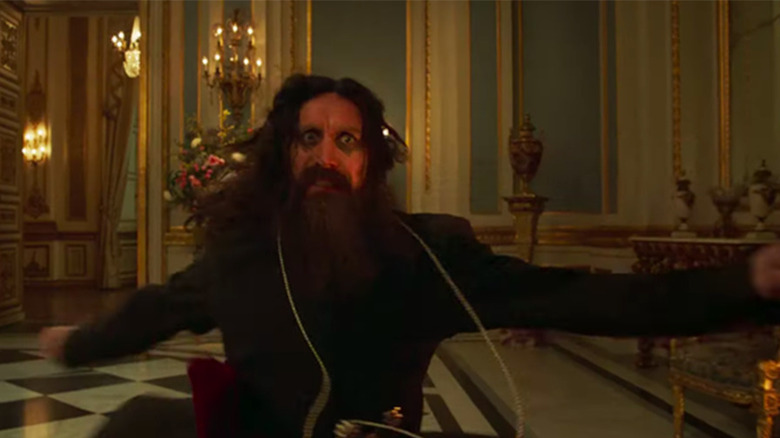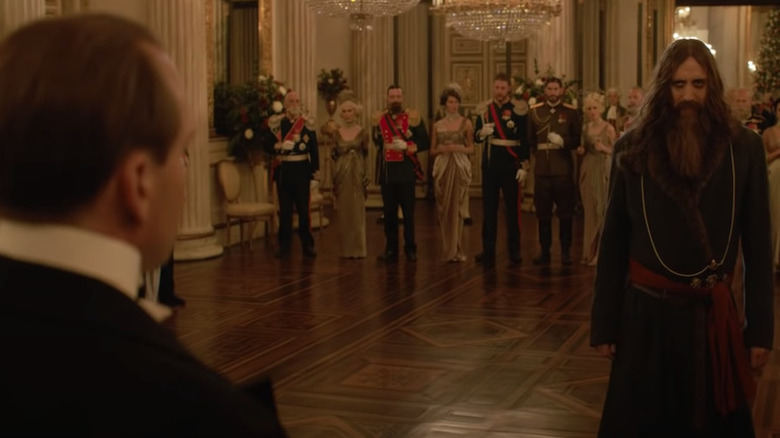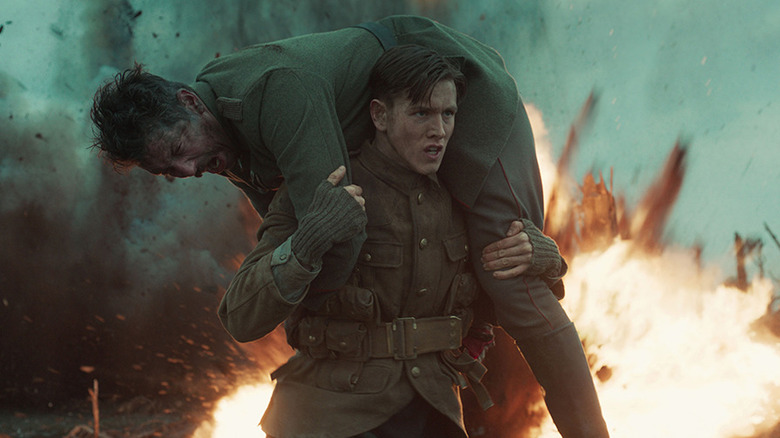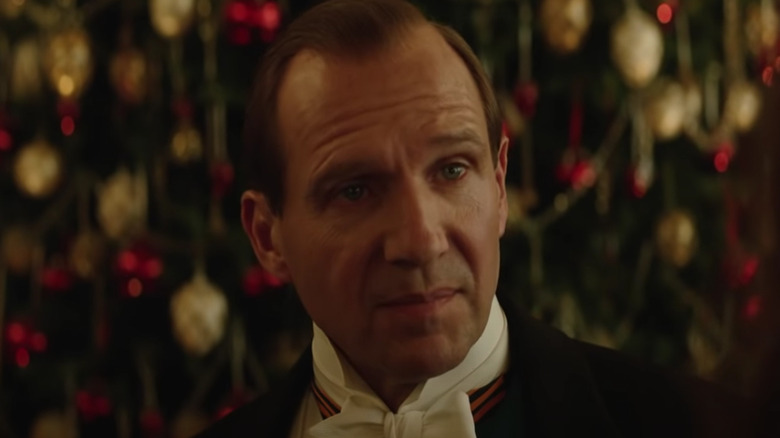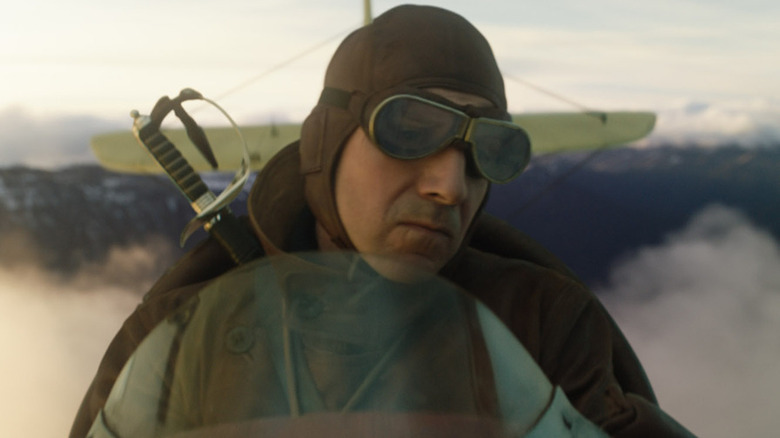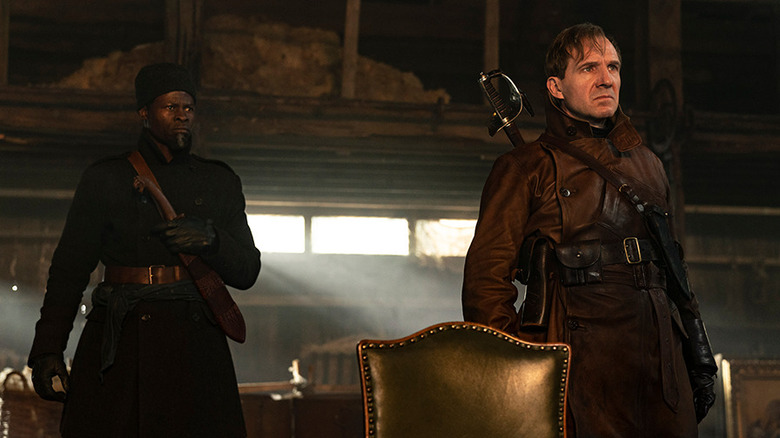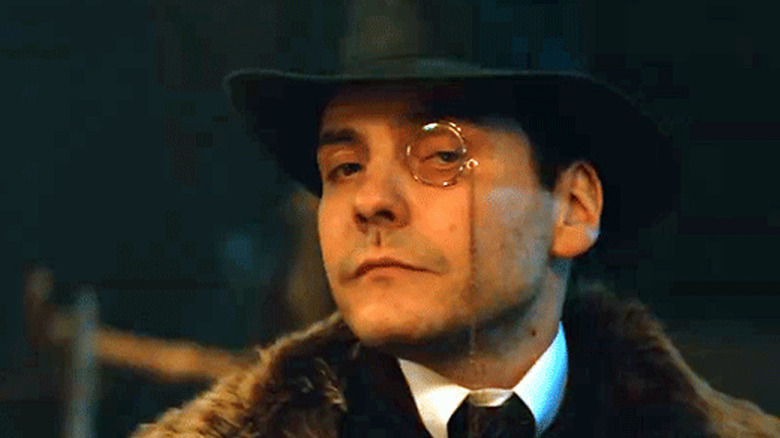The Best And Worst Moments In The King's Man
"The King's Man" is the latest entry in the "Kingsman" franchise, and it's certainly a departure from the previous installments. Unlike the preceding films, this one takes place during the First World War and before the Kingsman was a large organization. We follow Orlando, Duke of Oxford (Ralph Fiennes), and his son Conrad (Harris Dickinson) as they become entangled in the mysterious conspiracies behind World War I.
Throughout the film, it's shown that the events setting the war in motion are being masterminded by a shadowy figure known only as The Shepherd. At his disposal are fictitious interpretations of various historical figures, such as Rasputin and Mata Hari. Now, Orlando, Conrad, and their two associates — Polly (Gemma Arterton) and Shola (Djimon Hounsou) — must fight back against The Shepherd's sinister flock. "The King's Man" boasts many powerhouse performances and moments as well as some utterly baffling ones. These are just a few of the best and worst moments from "The King's Man."
Best — Conrad and Shola vs. Rasputin
One of the major highlights of the film is Rhys Ifans as a very crude and menacing Grigori Rasputin. Rasputin is one of the many historical figures depicted throughout the film and a key member of The Shepherd's flock. It's through his nefarious influence that Russia pulls out of the war, playing right into The Shepherd's hands. Orlando and his associates notice these sinister machinations and travel to Russia for an audience with the czar. This leads them into the path of Rasputin, whom they plan to dispose of via the use of a poisoned Bakewell tart.
After a bizarre (and tonally inconsistent) moment where Rasputin heals Orlando's injured leg with what appears to be magic, their ruse is discovered. The Mad Monk immediately tries to dispatch Orlando, who is quickly joined in battle by Conrad and Shola. What ensues is a wonderfully over-the-top fight sequence set to the tune of Pyotr Ilyich Tchaikovsky's "1812 Overture." It's not the first stylized action film the song has been used in, either — it previously made an appearance in "V for Vendetta." The sequence is definitely in tune with the eclectic and almost rhythmic fight scenes from the prior "Kingsman" films.
Worst — Rasputin heals Orlando's Leg
As noted previously, the scene where Orlando and his crew fight Rasputin is one of the film's major highlights. From Rhys Ifans' delightfully over-the-top performance to the use of classical music, it's an enthralling sequence. It is, however, not flawless, and contains one of the film's most bizarre, tonally out of place, and baffling scenes. During Orlando's one-on-one sit down with Rasputin, the Mad Monk looks to show Orlando the truth of his mysterious "powers." Now anyone with a cursory knowledge of history knows that the real Rasputin did not have any mystical healing powers. It's more likely that Rasputin simply made certain advisements about people's health, or his presence had a placebic, almost calming effect.
However, in "The King's Man," it's shown that Rasputin's powers are real within the confines of this universe. This is confirmed when Rasputin performs some form of blood ritual on Orlando's previously injured leg in a rather uncomfortable sequence. The process actually manages to fix his leg, allowing him increased mobility for the remainder of the film. Still, despite their over-the-top nature, the "Kingsman" films are more in line with James Bond movies, whereas this is more in line with "Harry Potter."
Best — Conrad runs across No Man's Land
Throughout the first half of the film, Conrad makes his intentions to fight in the war very clear to his father, Orlando. This is met with disapproval and concern from Orlando, spurred by the tragic death of his mother many years prior. Despite seeing success as a part of the proto-Kingsman, Conrad still sees it as his duty to serve in the war. He finally decides to disregard his father's wishes and enlists shortly after their return to England. Orlando makes one final hail mary attempt to prevent his son from doing so — he uses his status and influence to get him sent home. Conrad, equally as crafty as his father, circumvents this by switching places with another soldier played by Aaron Taylor-Johnson.
Conrad makes it to the front lines, warding off the enemy in the infamous No Man's Land, described by Smithsonian as "the most terrifying of places." During this section of the film, it's shown that a spy from England — carrying pertinent information necessary to ending the war — is stranded halfway across the battlefield. Conrad, ever the noble hero, throws caution to the wind and makes his way across No Man's Land to save his fellow soldier. He takes a page out of "Saving Private Ryan" and proceeds to throw the soldier over his shoulders and run. It's a well-crafted and suspenseful sequence, undermined only by its conclusion, where Conrad is killed due to an avoidable misunderstanding.
Worst — The blackmail of the president
After the death of Conrad, Orlando is left in a depressive state that isn't helped by excessive amounts of alcohol. This couldn't have occurred at a worse time, as The Shepherd has made another sinister move in his evil plan. One of his spies, the infamous Mati Hari (Gemma-Arterton), has used her charms to seduce the president, and the whole affair is captured on film. The Shepherd intends for this to keep the United States out of the war and get the president removed from office.
It bears repeating that this goofy development is what follows the tragic death of Conrad, one of the main characters. Absurdity in a spy film is far from out of place, but when it comes to depicting World War I, this was a baffling choice. Now, the use of blackmail for villainous reasons isn't uncommon — especially in spy films — but here, it's a definite tonal departure. There needed to be a more logical through-line between these radically two different plot points, and sadly the film falls short of that goal.
Best — Orlando subdues Mata Hari
Often, a simple scene showcasing the proficiency of your main character is enough to elicit intrigue and entertainment. For example, the first act of "Kingsman: The Secret Service" is almost entirely dedicated to setting up the character of Eggsy through a thrilling car chase sequence and several moments showing off his gymnastic/parkour skills that will be useful later. "The King's Man" does something similar, although later in its runtime and through very different means. After Orlando gets his confidence back after the unfortunate death of Conrad, he immediately jumps back into action.
Orlando cements his newfound second wind when he subdues Mata Hari, a German spy in league with The Shepherd. This coincides with the revelation that the president is being blackmailed to not join the war via illicit footage of him and Hari "together." Despite her charming facade and beauty, Orlando very quickly sees through her charade and is able to quickly subdue her. He follows up this moment by using the material of her scarf to deduce the location of The Shepherd's lair. It's a satisfying scene that echoes Sherlock Holmes and James Bond by properly showcasing our main character's skill and prowess.
Best — Orlando's parachute ride
"The King's Man" ticks almost all the boxes when it comes to war and spy movies, including an exciting aerial sequence. As The Shepherd is gearing up for his insidious end game, Orlando and his team devise a two-stage plan of attack to storm the antagonist's lair by land and air simultaneously. Orlando initially suggests Shola jump from the plane via the use of a then-brand-new invention known as a parachute. After some comical deliberations, Orlando decides he should be the one to make the risky aerial entrance.
So, as Shola and Polly engage The Shepherd's forces on the ground with guns and swords, Orlando begins his descent. All goes well until he experiences issues in the air while attempting to jump from his plane, threatening his life. He is able to engage the parachute but misses his mark and ends up lower on the treacherous mountain. Not to be done in, Orlando utilizes knives in his shoe tips to scale the remainder of the cliff. It's a scene similar in setup to Roxy taking out Valentine's satellite in the first "Kingsman" film, only far more anxiety-inducing.
Worst — The Shepherd reveals himself
Keeping your villain's true identity a secret for the majority of your film is an extremely calculated risk. If the reveal is unexpected and satisfying enough from a plot perspective, it can elicit great reactions from the audience. But if the reveal is underwhelming and poorly explained, it can irreparably sour the film's climax. Throughout the first two acts of the film, The Shepherd is kept either masked or hidden in the shadows. It isn't until the climax that his identity is revealed to be none other than Herbert Kitchener's right-hand man, Captain Morton.
It's unfortunately far from a mind-blowing twist, as Captain Morton hadn't had much of a presence up until that point. Outside of a one-off conversation with Conrad at the tailors, he plays very little significance throughout most of the film. Downplaying a character's presence isn't a terrible way to throw off suspicions, but sadly, it makes for a dud of a reveal in this case. His motivations are also weak and poorly explained, and the only inkling of his backstory given is a line about his family's mill being closed. Although the quality of the climax's final fight slightly makes up for it, it's nonetheless a deflating moment.
Best — Orlando vs. The Shepherd
After The Shepherd reveals himself to be Captain Morton, he and Orlando agree to a gentleman's sword duel. In the series timeline thus far, this is the initial use of its ironic "manners maketh man" quote, which is used by Harry in the first film. Shola agrees to let Orlando handle this battle on his own, serving as a bystander he engages in combat. It's a very impressive sword fight, elevated by the film's crisp direction, lack of intrusive shaky cam, and bombastic soundtrack. Intentional or not, it's clear that Orlando's fighting style was used as the basis for all subsequent Kingsman operatives. It's a neat detail, and one you could really only piece together by watching the trilogy back to back.
All seems to be going Orlando's way until The Shepherd breaks their gentleman's agreement and utilizes his sword's hidden gun. Shola, ever the ride or die bestie, takes the bullet for Orlando, but The Shepherd's underhanded tactics don't end there. Afterward, he throws a grenade at Orlando, and the blast knocks him through the lair's wall and to the cliff's edge. Things look hopeless for Orlando until one of The Shepherd's own goats — whom he'd abused earlier — stabs him with its horn. Once again, Orlando attempts to do the gentlemanly thing and not let him fall, but ultimately, he allows him to drop.
Best — The Kingsman are born
With The Shepherd defeated and the evidence of blackmail against the president retrieved, the United States joins the war. The film cuts ahead to the conclusion of the conflict, and we see England's post-war celebrations. Good has triumphed, and while his efforts will go unknown by the world, Orlando is content, having become the man Conrad hoped he would. But while this adventure is over, it appears there is still work to be done for Orlando.
In the final moments of "The King's Man," Orlando assembles his team — Polly and Shola — joined by the soldier who switched places with Conrad. The Duke of Oxford convenes with them and gives them new codenames, each based on the legend of King Arthur. He explains to them who they are and how they will be operating, officially forming the Kingsman. It's a wonderful scene and a fitting way to end this prequel story in a manner that fully elaborates on the franchise's lore.
Worst — The mid-credits scene
The Marvel Cinematic Universe's success has had a ripple effect on the world of cinema and blockbuster franchises. Now every director looks to set up future adventures via the use of a mid- and post-credits scene. The most famous example is Nick Fury coming to recruit Tony Stark for the Avengers after the credits of "Iron Man." "The King's Man" attempts to do something similar, but it might leave audiences more confused than intrigued.
Even though The Shepherd is gone, his influence unfortunately still lingers — as shown in the film's mid-credits scene. In this segment, we are shown Erik Jan Hanussen (Daniel Brühl) in some kind of subterranean lair conducting some business with another associate. He introduces this person to a new accomplice in their evil plans — a young man named Adolf Hitler. This connection has some context because Hanussen is known in real life as the man who taught Hitler how to command an audience. However, given this film's status as a prequel, it's rather confusing to consider where this development will even lead. Will the Kingsman of the modern era be fighting a high-tech neo-Nazi, or will we see another adventure from Orlando? It's a mildly interesting idea that could've been incorporated in a way that won't leave audiences confused.
